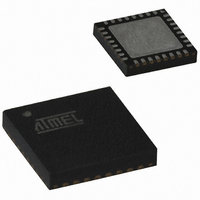AT89C5131A-PUTUM Atmel, AT89C5131A-PUTUM Datasheet - Page 94

AT89C5131A-PUTUM
Manufacturer Part Number
AT89C5131A-PUTUM
Description
IC 8051 MCU FLASH 32K USB 32QFN
Manufacturer
Atmel
Series
AT89C513xr
Datasheet
1.AT89C5130A-PUTUM.pdf
(188 pages)
Specifications of AT89C5131A-PUTUM
Core Processor
C52X2
Core Size
8-Bit
Speed
48MHz
Connectivity
I²C, SPI, UART/USART, USB
Peripherals
LED, POR, PWM, WDT
Number Of I /o
18
Program Memory Size
32KB (32K x 8)
Program Memory Type
FLASH
Eeprom Size
4K x 8
Ram Size
1.25K x 8
Voltage - Supply (vcc/vdd)
2.7 V ~ 5.5 V
Oscillator Type
Internal
Operating Temperature
-40°C ~ 85°C
Package / Case
32-VQFN Exposed Pad, 32-HVQFN, 32-SQFN, 32-DHVQFN
Core
8051
Processor Series
AT89x
Data Bus Width
8 bit
Maximum Clock Frequency
48 MHz
Data Ram Size
1.25 KB
Number Of Programmable I/os
34
Number Of Timers
16 bit
Operating Supply Voltage
2.7 V to 5.5 V
Mounting Style
SMD/SMT
Height
0.95 mm
Interface Type
2-Wire, EUART, SPI, USB
Length
7 mm
Maximum Operating Temperature
+ 85 C
Minimum Operating Temperature
- 40 C
Supply Voltage (max)
5.5 V
Supply Voltage (min)
2.7 V
Width
7 mm
For Use With
AT89OCD-01 - USB EMULATOR FOR AT8XC51 MCUAT89STK-10 - KIT EVAL APPL MASS STORAGEAT89STK-05 - KIT STARTER FOR AT89C5131
Lead Free Status / RoHS Status
Lead free / RoHS Compliant
Data Converters
-
Lead Free Status / Rohs Status
Details
Available stocks
Company
Part Number
Manufacturer
Quantity
Price
Part Number:
AT89C5131A-PUTUM
Manufacturer:
ATMEL/爱特梅尔
Quantity:
20 000
19.2.3
19.2.4
19.2.5
94
AT89C5130A/31A-M
SPI Serial Clock (SCK)
Slave Select (SS)
Baud Rate
This signal is used to synchronize the data movement both in and out the devices through their
MOSI and MISO lines. It is driven by the Master for eight clock cycles which allows to exchange
one byte on the serial lines.
Each Slave peripheral is selected by one Slave Select pin (SS). This signal must stay low for any
message for a Slave. It is obvious that only one Master (SS high level) can drive the network.
The Master may select each Slave device by software through port pins
vent bus conflicts on the MISO line, only one slave should be selected at a time by the Master
for a transmission.
In a Master configuration, the SS line can be used in conjunction with the MODF flag in the SPI
Status register (SPSTA) to prevent multiple masters from driving MOSI and SCK (see
Section “Error Conditions”, page 98).
A high level on the SS pin puts the MISO line of a Slave SPI in a high-impedance state.
The SS pin could be used as a general-purpose if the following conditions are met:
Notes:
In Master mode, the baud rate can be selected from a baud rate generator which is controlled by
three bits in the SPCON register: SPR2, SPR1 and SPR0. The Master clock is chosen from one
of seven clock rates resulting from the division of the internal clock by 4, 8, 16, 32, 64 or 128.
Table 19-1
Table 19-1.
• The device is configured as a Master and the SSDIS control bit in SPCON is set. This kind of
• The Device is configured as a Slave with CPHA and SSDIS control bits set
SPR2
configuration can be found when only one Master is driving the network and there is no way
that the SS pin could be pulled low. Therefore, the MODF flag in the SPSTA will never be
set
configuration can happen when the system comprises one Master and one Slave only.
Therefore, the device should always be selected and there is no reason that the Master uses
the SS pin to select the communicating Slave device.
0
0
0
0
1
1
1
(1)
.
1. Clearing SSDIS control bit does not clear MODF.
2. Special care should be taken not to set SSDIS control bit when CPHA =’0’ because in this
mode, the SS is used to start the transmission.
gives the different clock rates selected by SPR2:SPR1:SPR0:
SPR1
SPI Master Baud Rate Selection
0
0
1
1
0
0
1
SPR0
0
1
0
1
0
1
0
F
F
F
F
F
F
CLK PERIPH
Clock Rate
CLK PERIPH
CLK PERIPH
CLK PERIPH
Don’t Use
CLK PERIPH
CLK PERIPH
/128
/16
/32
/64
/4
/8
Baud Rate Divisor (BD)
(Figure
No BRG
(2)
128
16
32
64
4
8
This kind of
19-1). To pre-
4337K–USB–04/08

















